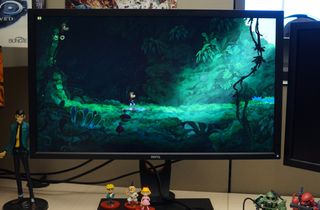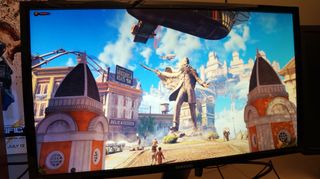The FreeSync and G-Sync monitors available now

Monitors and graphics cards can find it hard to deal with the fluctuating frame rates that we see in our PC games. When the refresh rates of your GPU and your monitor aren’t in sync, you get screen tearing. If you curtail that with V-Sync, you get slowdown when your GPU drops below the monitor’s refresh rate.

Need a refresher on the differences between TN, VA, and IPS panel types? Check out our guide to display technology.
That’s where Nvidia’s G-Sync and AMD’s FreeSync technology comes in. They both do the same basic thing: they allow a high refresh rate monitor to sync its refresh rate to the output of your graphics card rather than operate at a static frequency like 60 Hz. This keeps our games running nice and smooth, and it’s why a 144 Hz G-Sync monitor is currently our pick for the best gaming monitor around.
The technology has been around for a little while now, and there are a few dozen FreeSync and G-Sync monitors to choose from. However, tracking them all down and remembering all of the model numbers can be confusing, so we’ve done it for you.
If you’re thinking about buying a G-Sync or FreeSync monitor, here’s what you need to know.
Compatibility: what graphics cards do I need?
G-Sync: G-Sync only works with an Nvidia graphics card and monitors that include G-Sync hardware (you can use the monitor with any PC, you just won’t get the adaptive refresh rate). G-Sync works with Nvidia 600 series, 700 series, and 900 series cards. This also includes Nvidia’s Titan cards. There’s a full list of these cards on Nvidia’s website.
FreeSync: FreeSync only works with AMD graphics cards and monitors that support FreeSync (again, you can use the monitor with any PC, just without the adaptive refresh rate). All AMD Radeon R9 300 Series cards, as well as the R9 295X2, 290X, R9 290, R9 285, R7 260X and R7 260 graphics cards support FreeSync during gaming. All cards in the HD 7000, HD 8000, R7 and R9 Series support the technology for video playback and power-saving purposes. AMD APUs with the following codenames also support FreeSync using their built-in graphics processing: Kaveri, Kabini, Temash, Beema and Mullins.
It’s worth noting that FreeSync is based on a feature called Adaptive-Sync built into the DisplayPort standard. Adaptive-Sync is not proprietary AMD technology, so Nvidia could theoretically support it with its own graphics cards. As of December 2015, Nvidia only supports its proprietary G-Sync technology.
The biggest gaming news, reviews and hardware deals
Keep up to date with the most important stories and the best deals, as picked by the PC Gamer team.
Are G-Sync and FreeSync exactly the same?
Despite doing the same basic thing to your gaming experience, there are some key differences between G-Sync and FreeSync beyond what graphics cards they’re compatible with. Nvidia’s implementation of the technology includes some special hardware embedded in compatible monitors. This hardware affects how G-Sync performs when games run at a higher or lower refresh rate than the panel supports (e.g. 15 frames per second or 160 frames per second). When your in-game FPS goes below your monitor's minimum refresh rate, G-Sync doubles the frame rate that's being sent to the screen to keep the frame rate that the monitor perceives in the correct range.
AMD introduced a similar feature for FreeSync in its Crimson driver software in November. It now adjusts GPU output and refresh rate, however according to PC Perspective it only works on monitors where the max refresh rate is at 2.5 times the minimum refresh rate. This PCPer article goes into great depth to explain how G-Sync and FreeSync handle those refresh rates differently.
G-Sync added windowed mode support in May 2015, so the adaptive refresh rate works on the desktop and in windowed games, not just full-screen. AMD hasn’t yet announced plans for implementing windowed mode support for FreeSync.
Both FreeSync and G-Sync now have dual GPU support, so they should work fine if you’re running with Crossfire or SLI configurations.
FreeSync recently gained a small advantage over G-Sync in input flexibility: AMD announced that FreeSync will begin supporting HDMI in early 2016. For now, G-Sync is DisplayPort only.
FreeSync monitors
| AOC G2460PF | 24-inch 1920x1080 | 35 - 144 Hz | TN | $280 |
| AOC G2260VWQ6 | 21.5-inch 1920x1080 | 35 - 75 Hz | TN | $204 |
| AOC G2770PF | 27-inch 1920x1080 | 35 - 144 Hz | TN | $360 |
| Acer XG270HU | 27-inch 2560x1440 | 40 - 144 Hz | TN | $500 |
| Acer XR341CK | 34-inch 3440x1440 | 30 - 75 Hz | IPS | $1100 |
| Acer XR353CUB | 35-inch 2560x1080 | 144 Hz | VA | £650 |
| Asus MG278Q | 27-inch 2560x1440 | 40 - 144 Hz | TN | $550 |
| Asus MG279Q | 27-inch 2560x1440 | 35 - 90 Hz | IPS | $600 |
| BenQ XL2730Z | 27-inch 2560x1440 | 40 - 144 Hz | TN | $630 |
| Iiyama G-Master GB2788HS-B1 | 27-inch 1920x1080 | 144 Hz | TN | £270 |
| Iiyama G-Master GB2888UHSU-B1 | 28-inch 3840x2160 | 60 Hz | TN | £390 |
| Iiyama Prolite B2783QSU-B1 | 27-inch 2560x1440 | 50 - 60 Hz | TN | £290 |
| LG 34UM57 | 34-inch 2560x1080 | 60 Hz | IPS | $700 |
| LG 27UM67 | 27-inch 3840x2160 | 60 Hz | IPS | $500 |
| LG 29UM67 | 29-inch 2560x1080 | 48 - 75 Hz | IPS | $500 |
| LG 34UM67 | 34-inch 2560x1080 | 48 - 75 Hz | IPS | $650 |
| Nixeus Vue-24 | 24-inch 1920x1080 | 30 - 144 Hz | TN | $340 |
| Samsung S24E370 | 24-inch 1920x1080 | 60 Hz | PLS | £228 |
| Samsung S27E370 | 27-inch 1920x1080 | 60 Hz | PLS | £300 |
| Samsung U28E590D | 28-inch 3840x2160 | 60 Hz | PLS | $600 |
| Samsung U24E850R | 24-inch 3840x2160 | 60 Hz | PLS | $550 |
| Samsung U28E850R | 28-inch 3840x2160 | 60 Hz | PLS | $650 |
| Samsung U32E850R | 32-inch 3840x2160 | 60 Hz | PLS | $1200 |
G-Sync monitors
| Acer Predator XB270H Abprz | 27-inch 1920x1080 | 30 - 144 Hz | TN | $500 |
| Acer Predator X34 | 34-inch 3440x1440 | 60 - 100 Hz | IPS | $1,300 |
| Acer Predator Z35 | 35-inch 2560x1080 | 144 Hz | AMVA | $1,200 |
| Acer Predator XB271HK | 28-inch 3840x2160 | 60 Hz | IPS | $700 |
| Acer Predator XB271HU | 27-inch 2560x1440 | 144 Hz | IPS | $800 |
| Acer XB280HK bprz | 28-inch 3840x2160 | 30 - 60 Hz | TN | $700 |
| Acer Predator XB281HK | 28-inch 3840x2160 | 60 Hz | TN | $800 |
| Acer Predator XB321HK | 32-inch 3840x2160 | 60 Hz | IPS | £1,100 |
| Acer XB240H Abpr | 24-inch 1920x1080 | 30 - 144 Hz | TN | $385 |
| Acer XB270HU bprz | 27-inch 2560x1440 | 30 - 144 Hz | IPS | $800 |
| AOC G2460PG | 24-inch 1920x1080 | 30 - 144 Hz | TN | $500 |
| Asus RoG Swift PG279Q | 27-inch 2560x1440 | 30 - 165 Hz | IPS | $600 |
| Asus PG27AQ | 27-inch 3840x2160 | 60 Hz | IPS | £800 |
| Asus RoG Swift PG278Q | 27-inch 2560x1440 | 30 - 144 Hz | TN | $800 |
| BenQ XL2420G | 24-inch 1920x1080 | 30 - 144 Hz | TN | $540 |
| Dell S2716DG | 27-inch 2560x1440 | 30 - 144 Hz | TN | $800 |
| Philips 272G5DYEB | 27-inch 1920x1080 | 30 - 144 Hz | TN | $550 |
Most Popular


